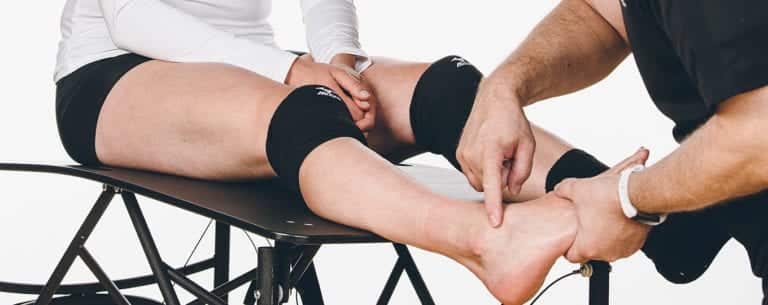
Have you ever thought about the fact that while knee bracing keeps advancing in terms of design and materials, ankle bracing advancement is stagnant? The only difference between the first lace-up (which was introduced over a century ago) and the lace-ups of today is a figure-8 strap has been added.
For this reason, some athletic trainers have started to rethink the use of a lace-up design that restricts non-injury range of motion, loses support rapidly, collects bacteria, stinks and is a pain to fit. Athletic trainers would never recommend a lace-up knee brace, which is why they are now rethinking why they would recommend a lace-up ankle brace. However, if not a lace-up ankle brace, then what is the best option for ankle injury prevention or mild/moderate ankle instability?
Athletic trainers tend to learn early on that the brace we prefer the athlete to wear and the ankle brace they will actually wear might be two different things. Take semi-rigid, hinged braces as an example – we see these ankle braces as providing more long-lasting ankle support, but the athlete sees them as being big, bulky and uncomfortable.
This leaves athletic trainer’s stuck between using an outdated and ineffective lace-up ankle brace or insisting their athletes wear bulky and uncomfortable semi-rigid, hinged braces. Instead of settling for these decades-old technologies, they are starting to rethink their methodologies by adopting a new ankle brace technology that has significant appeal to both athletes and athletic trainers.
The latest ankle brace advancements have resulted in products that are comfortable and low-profile enough to satisfy the athlete while utilizing a hinged-cuff design that provides long-lasting ankle support to meet the requirements of the athletic trainer. So, what is this emerging ankle brace design that satisfies both the athlete and athletic trainer? It all starts with a thermoplastic elastomer resin.
You may not know the term “thermoplastic elastomer” but it could become your best friend at preventing and treating the ankle injury. Rethinking the ankle brace starts with rethinking the material the ankle brace is made from. Thermoplastic elastomer material, trademarked Performathane® by Ultra Ankle®, is used to form the soft shell of the Ultra Zoom performance ankle brace. The Performathane soft shell reacts to body heat by form-fitting to the ankle for a comfortable custom-fit that athletes love. The hinged-cuff design of the Ultra Zoom restricts excessive inversion and rotation to help prevent both low and high (syndesmotic) ankle injuries.
Rethinking ankle bracing also comes with rethinking the cost per season. A lace-up ankle brace will typically last only a high school sports season or less. The Ultra Zoom typically lasts three full sports seasons making your cost per season much lower.
Every once in a while, we need to step back and rethink our bracing recommendations. Innovation moves forward with new techniques, materials and designs providing better outcomes for athletes and athletic trainers. At Ultra Ankle we keep advancing ankle bracing technology in order to perfect the best possible ankle brace for ankle injury prevention, chronic ankle instability and acute injury care.
SHARE WITH FRIENDS
RECENT POSTS
POST BY TOPIC
- Acute Ankle Injuries (7)
- Ankle Bracing (34)
- Ankle Injuries (16)
- Ankle Injury Prevention (20)
- Ankle Instability (6)
- Athletic Trainers (2)
- Athletic Training (3)
- Basketball (7)
- Football (9)
- High Ankle Sprain (4)
- Hiking (2)
- injury (1)
- Mild/Moderate Ankle Injury (2)
- News (2)
- Osteoarthritis (5)
- Pickleball (4)
- Soccer (5)
- Sports (16)
- Tennis (4)
- Ultra 360 Lace-Up (1)
- Ultra CTS (7)
- Ultra High-5 (1)
- Ultra Zoom (11)
- Volleyball (8)
